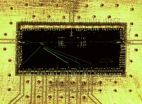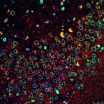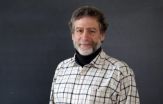(Press-News.org) DETROIT – The national practice guideline for treating MRSA-related pneumonia is seven to 21 days. A Henry Ford Hospital study found that effective treatment can be done in half the time.
Researchers found that 40 percent of patients were treated for eight to 13 days on a therapy of the antibiotics vancomycin or linezolid, and had the highest survival rate.
The Henry Ford study is believed to be the first to evaluate the length of treatment for MRSA-related pneumonia.
The study is being presented Friday at the annual Infectious Diseases Society of America meeting in San Diego.
"Based on our study, clinicians can effectively treat their patients within eight to 13 days, thus minimizing patients' exposure to antibiotics and their side effects," says Hadeel Zainah, M.D., a second-year Infectious Diseases fellow at Henry Ford and the study's lead author.
MRSA-related pneumonia is a respiratory illness that typically follows a bout of the flu. Symptoms include a cough, sore throat, head ache, shortness of breath, fever and chills.
In the retrospective study, researchers evaluated the medical charts of 115 patients hospitalized with MRSA pneumonia. Patients received either vancomycin or linezolid, or both.
Of the 115 patients, 32 died after 28 days. Other findings:
27 percent of patients were treated for 14-20 days.
13.9 percent of patients were treated for more than 20 days.
These treatment durations had lower survival rates than the eight to 13 days.
Researchers did not evaluate whether the treatment duration affected length of stay or whether one antibiotic fared better than the other.
INFORMATION:
The study was funded by Henry Ford Hospital.
Study: Optimal treatment duration for MRSA-related pneumonia
2012-10-20
ELSE PRESS RELEASES FROM THIS DATE:
Weight loss does not lower heart disease risk from type 2 diabetes
2012-10-20
Intervention stopped early in NIH-funded study of weight loss in overweight and obese adults with type 2 diabetes after finding no harm, but no cardiovascular benefits
An intensive diet and exercise program resulting in weight loss does not reduce cardiovascular events such as heart attack and stroke in people with longstanding type 2 diabetes, according to a study supported by the National Institutes of Health.
The Look AHEAD (Action for Health in Diabetes) study tested whether a lifestyle intervention resulting in weight loss would reduce rates of heart disease, stroke, ...
Breakthrough offers new route to large-scale quantum computing
2012-10-20
In a key step toward creating a working quantum computer, Princeton researchers have developed a method that may allow the quick and reliable transfer of quantum information throughout a computing device
The finding, by a team led by Princeton physicist Jason Petta, could eventually allow engineers to build quantum computers consisting of millions of quantum bits, or qubits. So far, quantum researchers have only been able to manipulate small numbers of qubits, not enough for a practical machine.
"The whole game at this point in quantum computing is trying to build a ...
Take control! Exploring how self-discipline works and how we might boost it
2012-10-20
Converging scientific evidence – not to mention a great deal of life experience – tells us that self-control is an important ability. It helps us keep our cool, get things done, and resist the things that tempt us. Scientists believe that gaining a clearer understanding of how self-control works could provide critical insights into addressing some of the large-scale problems facing society today, including obesity and addiction.
Numerous studies have found evidence for the idea of self-control as a limited resource, but emerging research suggests that this model may not ...
Salk scientists pinpoint key player in Parkinson's disease neuron loss
2012-10-20
LA JOLLA, CA---- By reprogramming skin cells from Parkinson's disease patients with a known genetic mutation, researchers at the Salk Institute for Biological Studies have identified damage to neural stem cells as a powerful player in the disease. The findings, reported online October 17th in Nature, may lead to new ways to diagnose and treat the disease.
The scientists found that a common mutation to a gene that produce the enzyme LRRK2, which is responsible for both familial and sporadic cases of Parkinson's disease, deforms the membrane surrounding the nucleus of a ...
Daily vibration may combat prediabetes in youth
2012-10-20
AUGUSTA, Ga. – Daily sessions of whole-body vibration may combat prediabetes in adolescents, dramatically reducing inflammation, average blood glucose levels and symptoms such as frequent urination, researchers report.
In mice that mimic over-eating adolescents headed toward diabetes, 20 minutes of daily vibration for eight weeks restored a healthy balance of key pro- and anti-inflammatory mediators and was better than prescription drugs at reducing levels of hemoglobin A1c, the most accurate indicator of average blood glucose levels, said Dr. Jack C. Yu, Chief of the ...
Disk galaxies formed gradually, astronomers find from images, computer simulations, and spectra
2012-10-20
Spectroscopic observations of distant galaxies taken with the 10-meter telescopes at the W. M. Keck Observatory on Hawaii, when combined with images taken by the Hubble Space Telescope plus supercomputer simulations to help interpret the observations, together reveal a major surprise: that a standard assumption about the evolution of galaxies is not correct.
Astronomers had thought that disk galaxies (like our own Milky Way) had largely finished forming by about 8 billion years ago, as indicated by the rates at which stars are formed in the Universe. Therefore, many astronomers ...
Science reveals the power of a handshake
2012-10-20
New neuroscience research is confirming an old adage about the power of a handshake: strangers do form a better impression of those who proffer their hand in greeting.
A firm, friendly handshake has long been recommended in the business world as a way to make a good first impression, and the greeting is thought to date to ancient times as a way of showing a stranger you had no weapons. Now, a paper published online and for the December print issue of the Journal of Cognitive Neuroscience on a study of the neural correlates of a handshake is giving insight into just ...
Dartmouth researchers explore how the brain perceives direction and location
2012-10-20
The Who asked "who are you?" but Dartmouth neurobiologist Jeffrey Taube asks "where are you?" and "where are you going?" Taube is not asking philosophical or theological questions. Rather, he is investigating nerve cells in the brain that function in establishing one's location and direction.
Taube, a professor in the Department of Psychological and Brain Sciences, is using microelectrodes to record the activity of cells in a rat's brain that make possible spatial navigation—how the rat gets from one place to another—from "here" to "there." But before embarking to go ...
NASA sees extra-large, now extra-tropical storm Prapiroon fading
2012-10-20
Prapiroon is both extra-large and now extra-tropical in the western North Pacific Ocean. NASA's Terra satellite captured an image of the large storm after Prapiroon became extra-tropical.
The Moderate Resolution Imaging Spectroradiometer (MODIS) instrument aboard NASA's Terra satellite captured a visible image of Extra-tropical Storm Prapiroon on Oct. 19 at 01:15 UTC (Oct. 18, 9:15 p.m. EDT). The storm appeared on the MODIS image to be as large as the main island of Japan and the strongest thunderstorms and heaviest rainfall appeared north of the center of circulation ...
Astronomers uncover a surprising trend in galaxy evolution
2012-10-20
VIDEO:
A study of 544 star-forming galaxies observed by the Keck and Hubble telescopes shows that disk galaxies like our own Milky Way unexpectedly reached their current state long after much...
Click here for more information.
A comprehensive study of hundreds of galaxies observed by the Keck telescopes in Hawaii and NASA's Hubble Space Telescope has revealed an unexpected pattern of change that extends back 8 billion years, or more than half the age of the universe.
"Astronomers ...





